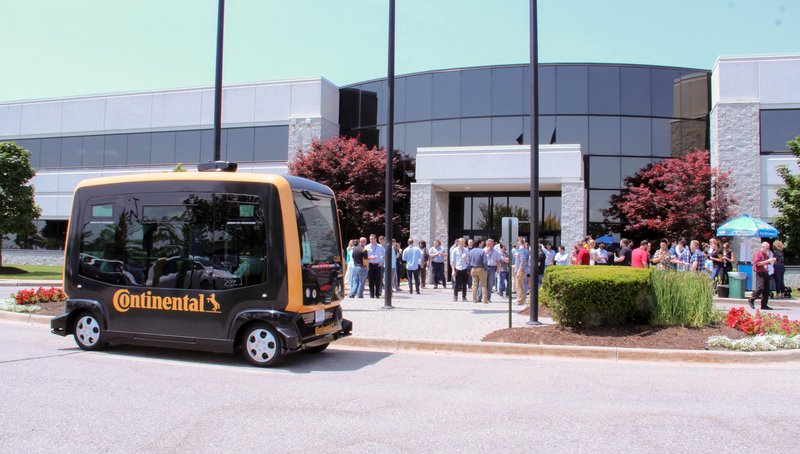Continental Launches Series Production of Technologies for Robo-Taxis
- Continental technologies such as ABS, radar and redundant brake system used in series production for robo-taxis for first time
- With CUbE development platform, real-world tests conducted in wide range of application areas for technology development
- New pilot project launches in Auburn Hills, Michigan
AUBURN HILLS, Mich., July 30 2019 — At technology company Continental, researchers and developers in North America, Europe and Asia are working to make proven series production technologies suitable for use in robo-taxis. While still rare on public roads today, driverless robo-taxis will become an important part of mobility in urban centers, helping to reduce traffic congestion and increase efficiency. This year, Continental’s technology for driverless vehicles will be in production for the first time in French company EasyMile’s EZ10 autonomous shuttle. Continental has held a stake in this driverless vehicle manufacturer since 2017.
Tailor-made technologies for driverless mobility systems
Continental has developed a production-ready radar system specifically designed for driverless vehicles. The vehicle can generate a 360-degree image of its environment by combining the data from different sensor technologies, ensuring redundancy and a higher level of accuracy than before. These radar systems function independent of visibility conditions and can even “see through” objects such as parked cars.
The central development platform for this work is the CUbE, a small driverless shuttle based on the EZ10 platform. The aim is not to develop the CUbE into a production vehicle, but to get a range of Continental technologies, such as brake systems and surrounding sensors, market-ready so that they can be used in robo-taxi series production.
“The technological building blocks that enable robo-taxis originate from high-volume car production and have been adapted for this new type of mobility,” said Jeremy McClain, Director of Systems & Technology, Continental North America. “While driverless vehicles are by their very nature revolutionary, the process will take place in evolutionary steps, in this instance drawing on the wide array of high-performance products and solutions from Continental.”
Continental’s radar sensor, which will be used in EasyMile’s EZ10 autonomous shuttle later this year, detects the vehicle’s environment within a radius of up to 200 meters. The vehicle is equipped with seven radar sensors, as well as laser sensors and cameras. These sensors allow the vehicle to determine its precise location, while detecting obstacles and potentially critical situations earlier.
Redundant brake systems and ABS functions for robo-taxis
Continental’s braking portfolio includes suitable technologies for robo-taxis, such as the MK C1 one-box brake system. This system has been in series production since 2016 and combines ABS, ESC and a brake booster. In autonomous vehicles, the one-box brake system is combined with a Hydraulic Brake Extension that can, in conjunction with ABS, safely brake the vehicle in the highly unlikely event of primary brake failure. Together, these systems form the production-ready MK C1 HAD brake system for highly automated driving and driverless mobility applications. The MK C1 HAD offers an additional safety benefit: the electromechanically generated maximum brake pressure is achieved after only 150 milliseconds. This means that without driver intervention, automated vehicles can now be brought to a standstill more quickly than with conventional brake systems.
This is the first time robo-taxis have been equipped with the ABS function, which will become especially important when driverless vehicles are on the road in wintry conditions. Vehicle dynamics systems such as ABS, ESC and traction control will enable vehicles to pull away safely on icy roads and provide maximum traction on slippery slopes or during braking.
Additionally, robo-taxis that are the size of small buses typically have a higher center of gravity than conventional cars, allowing passengers to enter and exit the vehicle comfortably in an upright position. A predictive driving dynamics system can ensure safe and stable handling around bends – now part of the range of innovative and high-performance vehicle control systems from Continental.
Research at locations worldwide with a single objective: the robo-taxi of the future
Development of these technologies is being conducted by a global network comprising Continental centers of excellence in the U.S., Germany, China, Japan and Singapore. At these locations, research and development work is carried out with different emphases, each making use of the CUbE platform with the common goal of future generations of safe and efficient robo-taxis. In dedicated areas, such as on a company premises or on special routes in clearly defined urban areas, driverless mobility services are in operation today. However, it is likely to take about another decade before robo-taxis become a common sight in normal traffic.
Continental, EasyMile, Oakland University, and the City of Auburn Hills in Michigan are set to implement the pilot deployment of an autonomous shuttle thanks to a grant from Michigan’s PlanetM mobility initiative, which supports companies in testing their technologies for future mobility. The pilot will begin in late August and last up to six months. The driverless shuttle will be deployed on the grounds of Oakland University, a sprawling and hilly college campus where navigation between buildings can be a challenge for students and faculty.
During the pilot, Continental will integrate its Zonar technology, which enables vehicle inspections via the Radio-Frequency Identification-based (RFID) Electronic Verified Inspection Reporting (EVIR) system. The EVIR system captures, transmits and records inspection, compliance and maintenance data to the operator. Additionally, the Zonar Z Pass technology detects where and when the passengers enter and exit the vehicle. The aim of this pilot project is to gather experience in the operation of driverless vehicles and to collect empirical data that will be integrated in the technological development of these vehicles.
Continental develops pioneering technologies and services for sustainable and connected mobility of people and their goods. Founded in 1871, the technology company offers safe, efficient, intelligent, and affordable solutions for vehicles, machines, traffic and transportation. In 2018, Continental generated sales of €44.4 billion and currently employs around 245,000 people in 60 countries and markets.

Kathryn Blackwell
Vice President, Marketing & Communications

